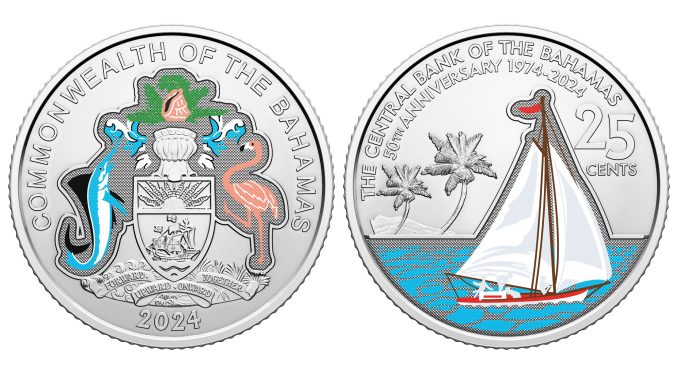The Royal Canadian Mint (RCM) is delighted to have won two prestigious Excellence in Currency awards at the International Association of Currency Affairs’ (IACA) 2024 Coin Conference in Lisbon, Portugal. The Mint was first recognized alongside the Central Bank of The Bahamas with the Best New Commemorative or Test Circulating Coin award for a world-first circulation coin featuring high-resolution colour on both the obverse and reverse of a coin marking the central bank’s 50ᵗʰ anniversary. As well, the Mint’s new, environmentally responsible process for plating bronze-coloured circulation coins earned the Best new coin product, process or manufacturing innovation award.

"The Royal Canadian Mint is dedicated to advancing the art and science of coin manufacturing, not just for Canada and Canadians, but also for the benefit of the global currency industry," said Marie Lemay, President and CEO of the Royal Canadian Mint.
"To be recognized in two award categories by IACA is a tremendous peer endorsement of our pursuit of innovation, which delivers great value for circulation coin users around the world and helps us find more caring and sustainable ways to produce our industry-leading products."
The 2024-dated 25-cent circulation coin celebrates the 50ᵗʰ anniversary of the Central Bank of The Bahamas. It was produced in collaboration with the Royal Canadian Mint, that applied its proprietary colour pad-printing technology to both sides of this ground-breaking coin. The obverse features the Coat of Arms of The Bahamas together with the words "Commonwealth of The Bahamas" which forms a crown around the Coat of Arms. Elements of the Coat of Arms are painted blue, white, pink, and green, highlighting the blue marlin, flamingo, and conch shell.
On the reverse is a rendering of a native sloop, infused with red, white, and brown paint, in sea painted blue, near an island, accompanied by the inscriptions "THE CENTRAL BANK OF THE BAHAMAS", "50th ANNIVERSARY 1974-2024". In addition to entering general circulation on June 3, 2024, this coin was also made available to collectors in custom packaging.
The Mint also developed and successfully scaled up a new electroplating process that is transforming the manufacturing of bronze plated circulation products by eliminating the use of cyanide required in traditional plating as well as harsh chemicals needed to treat waste water to municipal standards, and improving employee health and safety. The Mint’s new chemistry safely and reliably produces plated materials for both bronze mono-colour coins, as well as bi- or tri-metallic coins typically used for higher denominations.
The Excellence in Currency Awards were introduced by IACA in 2007 to promote and recognise excellence in currency issue, production, processing, management and distribution. The Mint is proud to have been recognized through several previous awards, most recently:
- The Best New Circulating Coin or Coin Series for its bi-metallic $2 circulation coin featuring a world-first black nickel-plated outer ring issued in honour of the late Queen Elizabeth II (2023);
- The Best New Commemorative or Test Circulating Coin for the Barbados $1 Glow-in-the-Dark Flying Fish circulation coin (2022);
- The Best Currency Initiative Implemented in Response to the Covid-19 Pandemic (Other Organization) special award for the Recognition Medal honouring Canada’s front-line workers and community difference makers (2021);
- Our tri-metal token technology, under the Best new coin product, feature or distribution innovation category (2019)
- our Canada 150 commemorative circulation coin program in the Best New Communications Program category (2017); and
- joint recognition with the Reserve Bank of New Zealand for New Zealand’s 50-cent Anzac 100ᵗʰ anniversary coloured circulation coin, in the Best New Commemorative or Test Circulating Coin category (2015).
About the Royal Canadian Mint
The Royal Canadian Mint is the Crown corporation responsible for the minting and distribution of Canada’s circulation coins. The Mint is one of the largest and most versatile mints in the world, producing award-winning collector coins, market-leading bullion products, as well as Canada’s prestigious military and civilian honours. As an established London and COMEX Good Delivery refiner, the Mint also offers a full spectrum of best-in-class gold and silver refining services. As an organization that strives to take better care of the environment, to cultivate safe and inclusive workplaces and to make a positive impact on the communities where it operates, the Mint integrates environmental, social and governance practices in every aspect of its operations.
About IACA
Working hand in hand with the public and private sector, IACA’s goal is to provide an international exchange for consultation and collaboration on matters of interest to stakeholders in the cash payments cycle and to give back to the industry through the benefits provided from our various project work, programs and information resources. Member companies include all stakeholders in the cash payments cycle, including: central banks; currency issuing authorities; ministries of finance; state and commerical printworks; state and commercial mints; cash management companies; currency industry suppliers and cash handling suppliers.





